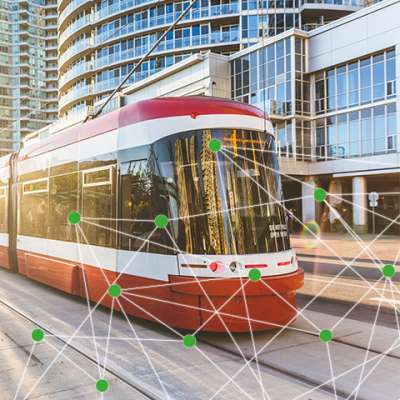Employee transportation management: What it means for the mobility of the future
Published February 7, 2024
- Organization & Change
- Travel, Transport & Logistics

Employee transportation management plays a decisive role in the mobility of the future. Commuters and commuter traffic have a significant share in CO2 emissions and the impending gridlock on motorways and in inner cities. Wavestone mobility expert Dr Isabella Geis explains the potential of smart mobility management for companies.

Employee transportation management is …
… in transition. Until about ten years ago, companies’ mobility offerings were mainly limited to company cars. The change came only in recent years – instead of relying exclusively on company cars, many companies are increasingly relying on a multimodal mobility offer. In principle, corporate mobility is a mirror of public mobility in cities and municipalities, with car and bicycle transport, public transport or even ride sharing offers.
Initially, the decisive factor was cost, but now questions of sustainability, climate protection, and employer attractiveness play an increasingly important role. And with every argument in favor of commuter flexibility, the range of what is provided has also changed. Whereas in the past it was simply a matter of being able to avoid building additional parking spaces and the associated costs, today the focus is more on employee retention and recruitment as well as CO2 reduction. Companies’ catalogue of measures therefore increasingly includes offers such as transportation stipends or bike leasing.

Employee transportation management can …
… significantly increase the attractiveness of a company for new hires, but also improve the loyalty of existing employees to the company – an effect that should not be underestimated in a time where skilled professionals are in short supply. If you want to remain attractive as an employer, you have to create appealing incentives such as public transport options, parking spaces for bicycles, or ride sharing opportunities. This ensures a positive corporate image for both employees and customers. The competition for qualified employees will not decrease and especially for young people, sustainable mobility is often a differentiator when choosing an employer. The right offer is different for every company and depends on individual factors such as the size of the company, mobility needs in everyday working life, or location.
With an employee transportation management system, alternatives can be created to the company car or even to travelling by car. In this way, costs for the vehicle fleet or parking spaces, for example, can be significantly reduced, which is also associated with economic advantages for the company. Finally, CO2 emissions can also be significantly reduced with the help of employee transportation management. It is worthwhile to electrify or even reduce the company fleet and to rely on alternative forms of mobility in order to comply with the specifications of the ESG directive and to make a contribution overall as a company to a sustainable society and the mobility turnaround.

Multimodal mobility is much more attractive today than it was ten years ago. Employee transportation management can be the answer to this change.

Employee transportation management needs …
… transparency because the transition of a company to an integrated mobility management approach is also a transformational process. For the success and acceptance of the planned measures, it is therefore very important to communicate transparently and comprehensibly and to involve both decision-makers and employees in the process in a targeted manner. This is because corporate mobility has a substantial impact on things like convenience, status, or even monetary benefits in many places.
Depending on the concept, it can mean that parking space requirements dwindle or company cars are only available to a significantly reduced extent or not at all, depending on how the company wants to approach it. This too is not always welcomed, so the introduction can have critical aspects. However, companies and employees also stand to gain. It is also important to make this clear: They gain flexibility, individuality, and innovation. We know that people today are much more interested in multimodal mobility than in the past and find it attractive. Employee transportation management can be the companies’ answer to this change. But this must of course be clearly communicated and conveyed – and above all planned in the same way in the concept. It is therefore all the more important to involve employees comprehensively at an early stage, for example by conducting employee surveys.
The HR department and, if necessary, employee committees or staff council should also be involved. Employee transportation management is not something that can be introduced “in passing”. Experience has shown that this leads to great resistance. But it is worth the while. And it works if the concept is geared to the needs of the employees, fits the company’s mobility behavior, and if the implementation and introduction has role models and faces that show how it works.
Commuting in Numbers
Globally, many commuters rely on cars for their daily journeys, though the numbers vary significantly by region. In Germany, for example, about 68% of employed people drive to work (Source: Federal Statistical Office, 2020). In the USA, this figure rises to approximately 76% (Source: U.S. Census Bureau, 2019). These differences reflect regional preferences and the availability of alternatives such as public transportation.
-
68% of employed people in Germany commute to work by car.
-
76% of workers in the USA use a car to get to work.
-

Employee transportation management will become …
… an essential factor for smart and sustainable mobility in the future – because we should not only think about it from the perspective of the individual company, but also from the perspective of a city, municipality, or entire region. Why should they tackle the transformation of mobility alone? Commuters generate a large share of traffic at peak times. It is in any city’s interest to get this under control. But not by making people stop working in their region, but by offering smart alternatives. Because where people work, there are jobs, economic progress, and innovation. This is important for regions as attractive employer locations.
The opportunities offered by the future of mobility – new technologies, digital transformation, business models, and a wide variety of mobility offers – are advancing mobility in general, but also corporate mobility. Provided that mobility management reacts flexibly and keeps up with the times. Whereas in the past it was mainly large companies that dealt with the issue of corporate mobility, in the future suitable concepts and solutions will also be a matter of course for small and medium-sized companies. Multimodal mobility solutions will become available that can be used individually and are available to all employees. And the surrounding region or municipality will become an enabler, mediator, and perhaps even supporter in its own sense, in the sense of the mobility turnaround and in the sense of attractive employers in the region.
Employee transportation management – where is it heading?
Employee transportation management is changing. While most companies used to only offer their employees company cars, many companies are now increasingly focusing on a multimodal mobility approach – not only to cut costs, but also to promote sustainability and climate protection as well as to strengthen employer attractiveness. For successful employee transportation management, transparency is particularly necessary to engage employees in this transformation process in the best possible way. This is because corporate mobility has a substantial influence on the issues of convenience, status, and monetary benefits in many places.
At the same time, companies and employees gain flexibility, individuality, and innovation and can make a major contribution to reducing CO2 emissions. In the future, employee transportation management will be an essential lever for smart and sustainable mobility – because all mobility players must work together for a successful mobility turnaround. In particular, the commuter traffic that companies generate is an essential factor and must be considered holistically as part of a city, a municipality, and an entire region.
Author
-

Dr. Isabella Geis
Associate Partner – Germany, Frankfurt am Main
Wavestone
LinkedIn